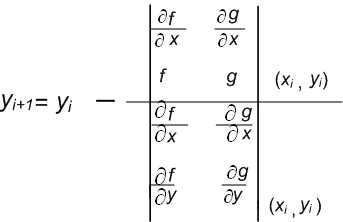
Next: Bairstow Method Up: Main Previous: Convergence of Newton-Raphson Method:
Fixed point Iteration:
Let ![]() be a root of
be a root of ![]() and
and ![]() be an associated
iteration function. Say,
be an associated
iteration function. Say, ![]() is the given starting point. Then
one can generate a sequence of successive approximations of
is the given starting point. Then
one can generate a sequence of successive approximations of ![]() as:
as:
![]()
...............
...............
.................
![]()
 (i.e. quadratic
convergence).
(i.e. quadratic
convergence).
Remark 1: One can
generalize all the iterative methods for a system of nonlinear
equations. For instance, if we have two non-linear equations
![]() then
given a
suitable starting point
then
given a
suitable starting point
![]() , the
Newton-Raphson algorithm may be written as follows:
, the
Newton-Raphson algorithm may be written as follows:
For i=1,2... until satisfied , do


Exercises: Solve the following systems of equations by Newton Raphson Method.
(1) ![]()
Use the initial approximation ![]()
(2) ![]()
Use the initial approximation ![]()